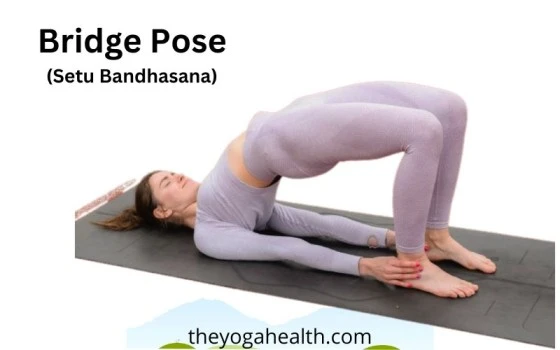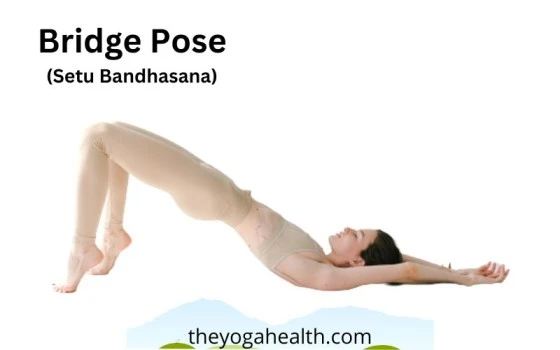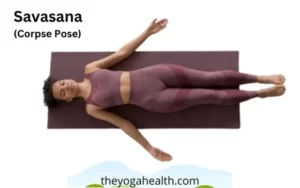Welcome to the world of yoga, where the ancient practice meets modern-day wellness. In this article, we will explore the transformative Bridge Pose Yoga (Setu Bandhasana), an essential posture that can pave the way for improved physical and mental well-being.
By learning about its meaning, benefits, variations, and safe execution, you’ll be equipped to integrate this powerful asana into your practice and experience its numerous advantages.
Table of Contents
Bridge Pose Yoga
The Bridge Pose Yoga also known as ‘Setu Bandhasana’ is a backbend Pose that is commonly practiced in yoga. Setu Bandhasana, its name in Sanskrit, is a combination of the terms “setu” (bridge), “bandha” (lock), and “asana” (pose).
This asana looks like the shape of a bridge, wherein the practitioner’s body forms a gentle arc. It’s a beginner-friendly pose that can be modified according to individual flexibility levels.
Meaning and Symbolism:
The Bridge Pose holds profound symbolism beyond its physical manifestation. Like a bridge, this asana connects different aspects of the self – the body, mind, and spirit. The arch formed by the body represents the link between the earth and the heavens, fostering a sense of balance and harmony.
Practicing this pose can be a transformative journey, bridging the gap between your present self and a more aware, resilient version of you.
Basic Details Setu Bandhasana:
Before diving into the practice, let’s cover the fundamental elements of the Bridge Pose. Lay on your back with your knees bent and feet hip-width apart, flat on the Yoga mat. Place your arms alongside your body, palms facing down.
Make sure your knees are in line with your ankles and that your feet are near to your buttocks. This is the preparatory position for the Bridge Pose.
| Sanskrit Name | Setu Bandhasana |
| English Name | Bridge Pose. |
| Position | Supine |
| Difficulty Level | Beginner |
Bridge Pose Benefits:
There are numerous health advantages of Bridge Pose for the mind, body, and spirit. As a beginner, understanding these advantages can motivate you to incorporate this asana into your regular practice:
- Strengthens the Back: Bridge Pose targets the back muscles, including the spine, lumbar, and gluteal muscles, fostering a strong and healthy spine.
- Stretches the Chest and Shoulders: The pose opens the chest and shoulders, counteracting the effects of prolonged sitting and hunching.
- Tones the Legs: This asana engages the quadriceps and hamstrings, promoting leg strength and flexibility.
- Improves Digestion: The gentle compression on the abdomen stimulates digestive organs, aiding in better digestion.
- Relieves Stress and Anxiety: Bridge Pose calms the mind, reducing stress and anxiety levels.
- Therapeutic for Thyroid Gland: The pose stimulates the thyroid gland, which helps regulate metabolism.
- Eases Menstrual Discomfort: Practicing this asana can alleviate menstrual discomfort and pain.
- Enhances Lung Capacity: The chest opening encourages deeper breathing, enhancing lung capacity.
How to Do Bridge Pose:
Step-by-step guide on how to perform the Bridge Pose:
Step 1: Lie on your back with your feet hip-width apart and your knees bent.Place your arms alongside your body, palms facing down.
Step 2: Lift your hips up while firmly planting your feet and arms into the ground. Keep your thighs and inner feet parallel.
Step 3: Interlace your fingers beneath your pelvis, extending your arms to create a supportive foundation.
Step 4: Roll your shoulders gently under and clasp your hands, pressing the arms into the mat to lift your chest towards your chin.
Step 5: Lengthen your tailbone towards your knees, maintaining a natural curve in your lower back.
Step 6: Hold the pose for 30 seconds to a minute, breathing deeply and evenly.
Step 7: To release, unclasp your hands, and lower your hips down to the mat, vertebra by vertebra.

Bridge Pose Variations:
Bridge Pose offers several variations that cater to different levels of flexibility and strength. These modifications allow beginners to ease into the posture and advanced practitioners to deepen their practice:
1.Supported Bridge Pose: Place a yoga block under your sacrum to provide extra support during the pose.
2. One-Legged Bridge Pose: Lift one leg towards the ceiling while maintaining the bridge with the other leg and hips.
3. Bridge Pose with Shoulder Opener: Interlace your fingers behind your back and straighten your arms while in the bridge position to open the shoulders further.
4. Wheel Pose (Chakrasana): An advanced variation that involves fully extending the arms and legs, creating a deeper backbend.
Tips For Beginners:
As a beginner, it’s natural to feel a bit apprehensive about attempting new poses. Here are some tips to help you embrace Bridge Pose with confidence and ease:
- Warm-up: Always warm up your body before attempting Bridge Pose. Engage in gentle stretches to awaken your muscles and prepare them for the asana.
- Use Props: Don’t hesitate to use props like a yoga block or a bolster to modify the pose and make it more accessible.
- Don’t Overdo: Start with a gentle lift of your hips and avoid excessive arching, especially if you have any back issues.
- Focus on Alignment: Pay attention to the alignment of your feet, knees, and hips. Keeping them in line will prevent strain on your joints.
- Breathe Mindfully: Remember to breathe deeply and evenly throughout the pose. This will help you stay calm and centered.
- Patience and Persistence: Rome wasn’t built in a day, and neither is your yoga practice. Be patient with yourself and celebrate every small improvement.
How to Practice Bridge Pose Safely:
Though Bridge Pose is generally safe for most individuals, it’s crucial to practice it mindfully to prevent any potential injuries. Here are safety guidelines to follow:
- Avoid Over-arching: Ensure your back maintains its natural curve, avoiding excessive arching that could strain your lower back.
- No Forceful Lifting: Lift your hips gradually, using your leg and gluteal muscles rather than forcefully pushing with your arms.
- Stable Foundation: Keep your feet grounded and distribute the weight evenly across your feet and shoulders.
- Listen to Your Body: If you experience any discomfort or pain, ease out of the pose immediately and consult a yoga instructor or healthcare professional if needed.
- Injuries and Medical Conditions: Before attempting this posture, speak with your doctor if you have a history of neck, back, or shoulder problems, as well as any medical issues like high blood pressure.
How Much Time to Hold Bridge Pose:
The duration of holding Bridge Pose can vary depending on your age, experience, flexibility and comfort level. As a beginner, aim to hold the pose for 30 seconds to a minute.
You can increase the time to 1-2 minutes as you improve and get more at ease. Avoid holding the pose for too long, especially if you feel strain or discomfort.
Preparatory and Follow-Up Poses:
To enhance the benefits of Bridge Pose, consider incorporating these preparatory and follow-up poses into your practice:
1. Preparatory Poses:
Reclining Bound Angle Pose (Supta Baddha Konasana): This gentle hip opener helps prepare the body for the bridge position.
Bridge Pose with a Block: Placing a block under your sacrum in the preparatory position can help you ease into the full pose.
2. Follow-Up Poses:
Child’s Pose (Balasana): Relax and stretch the spine after the backbend by transitioning into Child’s Pose.
Downward Facing Dog (Adho Mukha Svanasana): Transitioning into this pose can help release tension from the back and hamstrings.
Precautions for Bridge Pose:
Bridge Pose has several advantages, however it’s important to be aware of any possible risks:
- Recent Injuries: It is advisable to avoid this posture until you have fully recovered if you recently hurt your back, shoulders, or hips.
- Pregnancy: Pregnant women should modify the pose by using props or consult with a prenatal yoga instructor.
- Chronic Medical Conditions: Before attempting Bridge Pose, check with a healthcare provider or qualified yoga instructor if you have any chronic medical issues, such as osteoporosis or spondylolisthesis.
Contraindications for Bridge Pose:
Certain conditions and injuries may make Bridge Pose unsuitable for some individuals. Avoid this pose if you have:
- Recent or Chronic Neck or Back Injury
- Shoulder Injuries
- Severe Osteoporosis
- Spondylolisthesis
- High Blood Pressure
Tips for Bridge Pose:
Take your Bridge Pose to the next level with these helpful tips:
- Engage Your Core: Engage your core muscles to support your lower back as you raise into the pose.
- Lift Your Chest: Focus on lifting your chest towards your chin to avoid compressing your neck.
- Relax Your Jaw: Keep your jaw and facial muscles relaxed to maintain a sense of ease and tranquility.
- Visualize the Bridge: Imagine yourself as a strong, stable bridge connecting the earth and the sky.
- Practice Mindfulness: Be fully present in the pose, observing your breath and sensations without judgment.
Conclusion For Bridge Pose Yoga:
Bridge Pose Yoga (Setu Bandhasana) is a powerful asana that offers a gateway to improved strength, flexibility, and inner harmony.
As you continue on your yoga journey, remember that consistent practice, patience, and self-awareness are the keys to unlocking the transformative benefits of Bridge Pose.
May Bridge Pose Yoga serve as a steadfast companion on your journey to wellness and self-discovery. Good Luck!
FAQs: Bridge Pose Yoga
Q1: What is Bridge Pose ?
A: Bridge Pose, also known as Setu Bandhasana, is a yoga asana that involves lifting the hips while lying on your back, creating a bridge-like shape with the body. It is a famous backbend pose that has several advantages for power, flexibility, and general health.
Q2: Is Bridge Pose suitable for beginners?
A: Yes, Bridge Pose is beginner-friendly and can be modified to suit different levels of flexibility and strength. It’s an excellent introductory backbend for those new to yoga.
Q3: What are the benefits of practicing Bridge Pose?
A: Bridge Pose has several benefits, including strengthening the back, stretching the chest and shoulders, toning the legs, improving digestion, and reducing stress and anxiety. It is also therapeutic for the thyroid gland and can alleviate menstrual discomfort.
Q4: How long should I hold Bridge Pose?
A: As a beginner, aim to hold the pose for about 30 seconds to a minute. You can gradually extend the time to 1-2 minutes as you gain skill and comfort.
Q5: Can Bridge Pose help with back pain?
A: Yes, Bridge Pose can be beneficial for relieving mild back pain by strengthening the back muscles and promoting a healthy spine. Before attempting the pose, though, it’s crucial to speak with a doctor or a yoga instructor if you suffer from chronic or severe back pain.
Q6: Can pregnant women practice Bridge Pose?
A: Pregnant women can practice Bridge Pose with modifications, such as using props like a bolster or consulting with a prenatal yoga instructor. However, it is best to speak with a doctor before starting any yoga poses while pregnant.
Q7: Are there any precautions for practicing Bridge Pose?
A: Yes, there are some precautions you should take, such as avoid the pose if you have high blood pressure, severe osteoporosis, shoulder injuries, or recent or on-going neck or back problems. Always be careful and listen to your body limits and avoid overstretching or pushing beyond your capacity.
Q8: Can I do Bridge Pose if I have a medical condition?
A: Before attempting Bridge Pose, it’s important to speak with a medical expert or an accomplished yoga instructor if you have any health issues or injuries.They can provide personalized guidance based on your specific condition.
Q9: Can I perform Bridge Pose if I have never done yoga before?
A: Yes, Bridge Pose is suitable for beginners and can be incorporated into a beginner’s yoga practice. But if you are new to yoga poses, it is crucial to start carefully and practice under the supervision of a trained yoga professional.
Q10: What are some preparatory poses for Bridge Pose?
A: Preparatory poses for Bridge Pose include Reclining Bound Angle Pose (Supta Baddha Konasana) and Bridge Pose with a Block, which help open the hips and prepare the body for the backbend.
Q11: Can I do Bridge Pose on my own, or should I join a yoga class?
A: While practicing Bridge Pose on your own is possible, joining a yoga class or working with a certified yoga instructor can provide valuable guidance on proper alignment and modifications tailored to your individual needs.
Q12: Can I perform Bridge Pose every day?
A: It is important to pay attention to your body limits and avoid pushing yourself too far in any yoga practice. Practicing Bridge Pose every day can be beneficial, but be mindful of any signs of strain or discomfort. It’s also a good idea to incorporate other yoga poses to maintain a balanced practice.
Q13: Can Bridge Pose help with stress and anxiety?
A: Yes, Bridge Pose can help reduce stress and anxiety by calming the mind and promoting relaxation. The chest opening in the pose can also encourage deeper breathing, which has a calming effect on the nervous system.
Q14: Are there any variations of Bridge Pose?
A: Yes, Bridge Pose offers several variations, including Supported Bridge Pose, One-Legged Bridge Pose, Bridge Pose with Shoulder Opener, and the more advanced Wheel Pose (Chakrasana).
Q15: Can Bridge Pose improve my posture?
A: Yes, practicing Bridge Pose regularly can help improve posture by strengthening the muscles in the back and shoulders and promoting a healthy alignment of the spine.
Q16: Can Bridge Pose help with menstrual discomfort?
A: Yes, Bridge Pose can be beneficial for easing menstrual discomfort and pain by stretching and opening the pelvic area. It’s also known to stimulate the reproductive organs, which can help with menstrual health.
Q17: How does Bridge Pose benefit the thyroid gland?
A: Bridge Pose stimulates the thyroid gland, which is responsible for regulating metabolism. The gentle compression on the throat area in the pose can be beneficial for thyroid function.
Q18: Can Bridge Pose improve my flexibility?
A: Yes, Bridge Pose stretches and opens the chest, shoulders, and hip flexors, contributing to improved overall flexibility with regular practice.
Q19: Can I practice Bridge Pose in the evening?
A: Yes, you can practice Bridge Pose in the evening. However, it’s best to avoid doing hard backbends right before bed if you have insomnia or other sleep issues.
Q20: Can I do Bridge Pose as part of my warm-up routine?
A: Yes, Bridge Pose can be included in a warm-up routine to gently stretch and activate the muscles before engaging in more challenging poses. However, it’s essential to incorporate other warm-up exercises as well to prepare the entire body for the practice.
Share your experience of doing Bridge Pose Yoga (Setu Bandhasana) and let us know if you have any questions or comments regarding this Pose in the comments section below.






